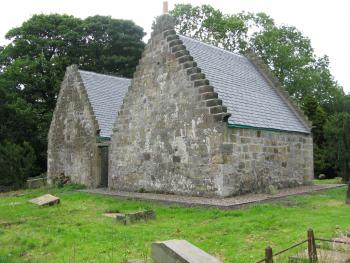- Navigation:
- Back to the Corpus index page
- RSS
Leslie / Fithkil Parish Church
Leslie, Church, burial aisles from north west
- Dedication: unknown
- Diocese of Dunkeld
- Deanery of Fife and Strathearn
- County of Fife
- Fife Council
- NO 2559 0207
Summary description
There are no identifiable remains of the medieval church, but its location is indicated by the survival of two post-medieval aisles that were evidently added against its northern flank.
Historical outline
Dedication: unknown
No records of the church of Leslie survive from before 1239. In that year, what appears to have been a bitter dispute over the patronage of the church between Geoffrey, bishop of Dunkeld, and his chapter on one side, and Merleswain, son of Waltheof, lord of Ardross, on the other, was settled by judgement of the papal legate, Otto, and four arbiters, in favour of the secular patron.(1) It was agreed that Merleswain and his heirs would retain the patronage of Leslie for all time, but the church would be erected into a prebend of Dunkeld after the resignation or death of the incumbent rector, Master John of Everley, who had been presented by Merleswain. At that time, Merleswain would present a suitable candidate to the bishop for collation, the prebendary thereafter paying 10 merks annually to the common funds of the cathedral.
Although a fine of 1000 merks was meant to be imposed on either party should they break this settlement, it is evident that it was ineffective and that the dispute had continued into the early 1260s between the bishop and the heiresses of the Ardross lordship. In c.1263, Merleswain’s daughter, Scholastica, with consent of her husband, Richard, confirmed her gift of the right of patronage to the canons of Inchcolm.(2) Around the same date, Alexander Comyn, earl of Buchan, and Thomas Meldrum, both of whom claimed the patronage by right of lordship, quitclaimed that right to the canons.(3) With all lay interest in the church thus resigned, Richard de Inverkeithing, bishop of Dunkeld, confirmed the church in proprios usus to the abbey.(4) The parsonage remained appropriated to Inchcolm at the Reformation, with the 10 merks annual payment to the common funds of Dunkeld still being deducted from its revenues. A vicarage may have been established, held on occasion by one of the canons, but this seems to have been a vicarage pensionary only.(5)
There is reference in the fourteenth century to a chapel of St Mary in the cemetery of Leslie. In March 1320/1, a settlement was reached between the canons of Inchcolm as rectors of Leslie and Richard of Kirkcaldy, rector of Melville, over this chapel, whereby Richard quitclaimed any right which he had in it.(6) There appears to be no further surviving reference in the documentary record to this chapel and its omission from the Book of Assumptions of Thirds of Benefices suggests that it was not served with an endowed chaplainry of any significance.
Notes
Architectural analysis
Although there is no identifiable surviving fabric, the location of the medieval church is indicated by a pair of adjacent burial aisles that appear to be of seventeenth-century date, and that were built for the Earls of Rothes and the Douglas of Strathendry family. These were clearly on the north side of the church since, when a new church was built a short way to the south of the medieval building, the exposed southern ends of the two aisles had to be refaced. An echelon grouping of three blind lancets around a central entrance arch is the main feature of each of the two new fronts, and there is a further blind lancet in the screen wall that was built to interconnect the two aisles. Although they were not contiguous, the narrow space between the two aisles must have been roofed at some stage, since a fireplace was provided in the east wall of the western aisle. The refacing of the aisles was presumably carried out when the new church, known as Christ’s Kirk on the Green, was built in 1819-21 by Thomas or James Barclay, and possibly to the designs of Alexander Leslie. That church was later extensively remodelled to the designs of James Maitland Wardrop in 1868-9, and it bears a tablet inscribed with the date 1869. The church has now been secularised.
There are no traces of the chapel of St Mary referred to in 1320/1 and, although it might be seen as a possibility that it provided a basis for one of the two burial aisles, on balance that seems unlikely.
Bibliography
Charters of the abbey of Inchcolm, 1938, ed. D.E. Easson and A. Macdonald, (Scottish History Society), Edinburgh, nos 18, 25, 26, 27, 32, 49.
Cowan, I.B., 1967, The parishes of medieval Scotland, (Scottish Record Society), Edinburgh, 130.
Gifford, J., 1988, The Buildings of Scotland, Fife, London, 303-4.
Kirk, J., 1995, The books of assumption of the thirds of benefices, (British Academy) Oxford, 62, 82, 300.
New Statistical Account of Scotland, 1845, Edinburgh and London, ix (Fife), 120.
Map
Images
Click on any thumbnail to open the image gallery and slideshow.









